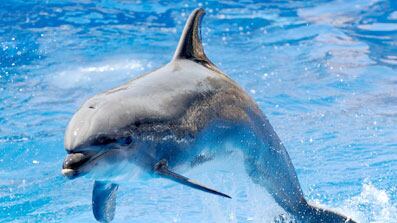Most of the focus on the ecological impact of BP’s oil gusher has been on the coast, where the effects of slimy oil slicks are most visible. But scientists are quietly worrying that the estimated 125,000 dolphins that roam the Gulf of Mexico may be at risk—and that the harm to them from the oil will be next-to-impossible to measure.
While there haven’t been any reports of dolphins in the 100-mile-wide oil slick, it’s just a matter of time until someone spots one. Wild dolphins are known to swim, feed, and play in slicks along the surface, though trained dolphins seem to know to avoid them.
Click Below to View Our Gallery of the 11 Animals Most Threatened by the Spill

But along with whales, their mammal cousins, dolphins may face more danger over the long term below the surface of the sea. And that’s not only due to the more than 3 million gallons of oil that have contaminated the Gulf already.
• Rick Outzen: A Florida Official Calls the Feds on BP The explosion that destroyed the Deepwater Horizon platform in April occurred 60 miles from the Louisiana shore and the oil gusher is a mile deep, with the crude rising to the surface. The government and BP are trying to keep as much of the spill from striking the coast as possible, using an unprecedented amount of dispersant to treat the oil on the surface and ocean floor. That chemical, which breaks up the oil into little drops, allows different constituents of the crude to fall far below the surface. The more of the oil that stays out at sea, the less that ends up on the shores of the Gulf, figure officials, and it’s the sensitive wetland habitats there that anchor some of the country’s most important marine ecosystems.
Scientists have very little data on how the oil at sea might affect the Gulf’s teeming populations of dolphins and whales. If ingested or touched, the oil can cause irritation or damage to the respiratory tract, though experts know of only a handful of previous instances where dead dolphins have washed ashore after spills. According to marine ecologist Lisa Ballance of the National Oceanic and Atmospheric Administration, scientists believe that prolonged exposure to oil at low doses can have a long-term impact on dolphins. “But we don’t understand much about the mechanism that causes it,” she says.
A number of possibilities exist. Toxins in the water might kill the fish that dolphins eat, depriving them of food, or their prey may deliver small doses of oil that may have long-term effects. Or it might be ingested in small doses over time as the dolphins swim.
The best clue scientists have about oil’s effects on marine mammals comes from studies of pods of killer whales whose grounds were polluted by the Exxon Valdez disaster in 1989. After one year, said Ballance, one-third of the whales in one pod disappeared and 40 percent of the whales in the other were gone as well. (Sixteen years later, scientists saw numbers restored in one pod but not the other.) The biologists couldn’t know for sure whether the missing whales had died and whether oil was to blame.
Ballance said the massive spill can’t be good for the dolphins or the fish they eat, and that they deserve just as much attention as the wetland species that get all the press. “Humans in general have a very coast-centric view of oil spills, and we really don’t know the long-term effects of oil,” she says.
Given the vastness of the Gulf and the fact that dolphins may die far out at sea, it will be very difficult for scientists to track the effects of the oil at all. So the oceans’ smartest, most majestic mammals may face a toxic culling we’ll never know about for sure.
Science magazine’s Eli Kintisch just published Hack the Planet: Science's Best Hope—or Worst Nightmare—for Averting Climate Catastrophe.





